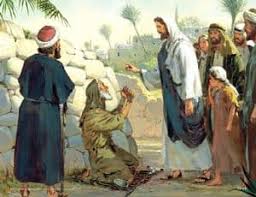Jesus’ Reception at Gennesaret
Matthew 14:34-36 and Mark 6:53-56
Jesus’ reception at Gennesaret DIG: What kind of a place was Gennesaret? Why might the Meshiach want to go there with His apostles? What was the scene like when they landed? Why? What was significant about the tassels of Yeshua’s robe?
REFLECT: What desperate measures would you go to if you knew there was someone who could heal your fatal illness, or deformed friends or loved ones? When in your life have you ever used God? What caused you to stop? Or do you still do it? How? Why?
After the eventful crossing of the Sea of Galilee by walking on the water, the talmidim and their Galilean Rabbi landed back in Jewish territory. The Sea of Galilee, which was really a lake, was sometimes called Tiberias. When they had crossed over, they landed at Gennesaret and anchored there (Matthew 14:34; Mark 6:53). This would be along the northwest shore of the lake stretching from the town of Migdal nearly to Capernaum and north of modern Tiberias. It is also the site of the 1985 discovery of a fishing boat from the period of Christ, now on display at Kibbutz Nof-Ginosar.810
Gennesaret was a small but very beautiful plain located southwest of Capernaum. According to Josephus it was a lush and extremely fertile area that produced a wide variety of crops. The fields and vineyards were irrigated from not less than four large springs, enabling farmers to produce three crops a year. Because the soil was so rich the area was totally devoted to farming and contained no towns or villages. As a result, it was a quiet and peaceful region offering a good place to get away from the crowds and rest. Jesus probably intended to spend some time there alone with His apostles.811

But as soon as they got out of the boat the people of that place recognized Christ (Mark 6:54). The verb recognized is epiginosko, meaning to know by experience. The people recognized the Lord because they had seen Him before. Word of His miraculous healing powers preceded Him and they sent word throughout the entire area and brought everyone who was ill. They ran throughout that whole region and carried all their sick on mats to wherever they heard He was (Matthew 14:35; Mark 6:55). And wherever He went – into villages, towns or countryside – they placed the sick in the marketplaces (Mark 6:56a). What a desperate picture. The people kept running from place to place, carrying all their sick on mats from one place to another. Wherever Jesus was reported to be, or wherever it might be possible to find Him, they ran to Him. This section serves as a summary of Messiah’s ministry in Galilee before He withdrew to other regions. It resembles summaries in Mark 1:32-34 and Mark 3:7-12, except that no mention is made of casting out demons. In it we see the widespread fame of Yeshua the healer.
Nevertheless, the Lord responded to the personal needs. They begged Him that the sick people might only touch the tassels (Hebrew: tzitzit) on His robe (see Matthew 9:20), and all who touched it were completely healed (Matthew 14:36; Mark 6:56b CJB). If someone had the gift of healing today that Jesus demonstrates here, that person could go into hospitals and clear them out, go into cancer wards and all would be completely healed. The Meshiach healed with a word or a touch, He healed organic diseases from birth and He raised the dead. Anyone who claims to have the gift of healing today should be able to do likewise.
The fact that He wore tassels on the edges of His robe tells us that our Savior was an observant Jew obeying the commandments of the Torah (Numbers 15:37-41). In modern Judaism, many traditional Jews continue to wear the arba kanfot, the four-cornered undergarment that contains the tassels. This is called a tallit katan (small prayer shawl), while the more popular version is the tallit (prayer shawl) worn by many Jewish men at morning synagogue services. The way in which the tassels are tied with double knots adds up to the numerical value of 613, which is the number of commandments in the Torah.812
He was surrounded by multitudes of people. They were mesmerized by His powers. I am sure that at some point the Good Shepherd looked on the crowd with a kind of sadness, because there was hardly a person in them who had not come to get something out of Him. They came to get. They came with their relentless demands. They came – to put it bluntly – to use Him. What a difference it would have made if among the people there had been some who came to give and not to get. In a way it is quite natural that we should come to Jesus to get things from Him, for there are so many things that He alone can give; but it is always a shameful thing to take everything and to give nothing, and yet it is very characteristic of the human heart.
If we examine ourselves we are all, to some extent, guilty of using ADONAI. It would cause Christ to rejoice if more often we came to Him to offer our love, our service, our devotion, our adoration, and less often to demand from Him the help we need.813



Leave A Comment